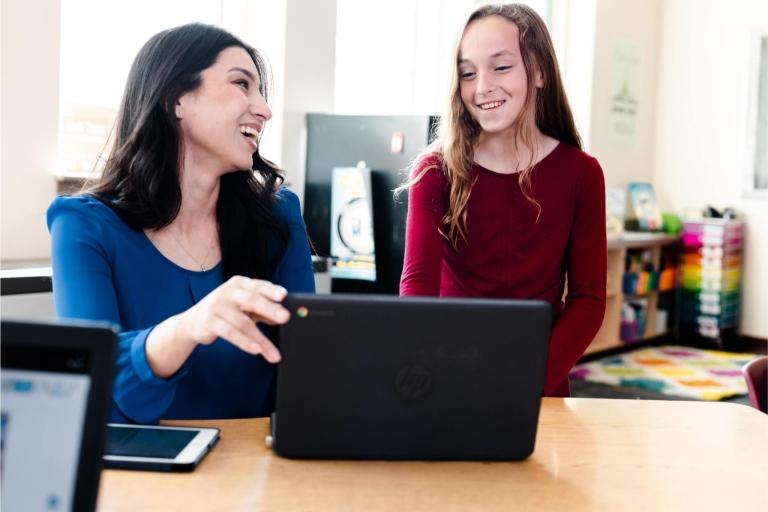
With constant tech advancement in education, the classroom is experiencing rapid change, evolving learning and teaching in K-20. The growth of artificial intelligence has contributed to this academic shift as it begins to plant its roots in education. It’s clear–AI is here to stay and will continue to transform and impact edtech. As a result, many institutions and educators are welcoming AI solutions in efforts to foster student success. According to one of our recent surveys, sentiment about AI is primarily positive, with 54.5% of teachers, students, and administrators feeling optimistic about the benefits of technology in the classroom.

However, AI’s initial introduction in education was met with concern. But as with anything new, it takes time to make adjustments. We continue to advocate for a human-centered, safe, equitable approach to AI in the classroom. For instance, AI is used to support personalized learning approaches and help teachers save time during planning and instruction. In this article, we will take a look at AI’s effects on teaching, explore best practices, and discover emerging AI tools that can enhance instruction.
What is AI for Teaching and Learning?
Artificial intelligence is an umbrella term for the many types and definitions of AI functions. Most are familiar with the generative AI model, which quickly produces text, graphics, etc. By the end of the 2023-2024 school year, roughly 30% more people expect to have tried using generative AI for school work than today. In addition, roughly 50% more respondents anticipate using it for school work at some regular interval.
Still, there are other AI models beneficial to the classroom. To learn more about the other types of AI and their definitions, take a look at our article Tips to Understanding AI for Today’s Classroom.
Yes, we understand the overall learning and teaching process can be enhanced with AI tools. But how exactly are teachers and students benefiting from AI tools in their classrooms? Here are a few benefits:
- Task Automation and Process: Educators can automate tasks, making their day-to-day easier and giving them more time to focus on their students and class.
- Personalization: Students can easily receive personalized and differentiated approaches to instruction, fitting to their learning journey.
- Interactive Learning: Students are engaged by tech and digital learning tools; automation can improve participation and effectiveness.
- Planning and Organization: Teachers can reduce planning time and outsource ideas using AI.
- Accessibility: Educators can use AI to provide accommodations to students with disabilities.
These are just a few advantages to utilizing AI. However, to best use AI in the classroom, teachers need to know the most effective ways to teach with it. Read on to learn about best instructional AI practices.
Three Practices for Teaching with AI
About one-third (30.6%) of students and educators surveyed were most familiar with OpenAI's ChatGPT. When ChatGPT gained popularity, it was initially considered a risk to the academic world. But as we learn more about AI, it is seen as a learning solution to academic challenges.
As AI quickly takes its seat in education, how can teachers use it best? Instead of going against AI, teachers are finding effective ways to implement it into their teaching strategy. Here are three AI teaching practices to start facilitating learning and engagement in the classroom:

Personalize the Learning Experience: Teachers can create personalized learning experiences for their students, adapting to their learning needs. By using AI-powered tools, student performance and needs are analyzed, helping to deliver tailored content. Learn more about personalized learning with differentiation.
Encourage Brainstorming and Collaboration: Generative AI can help foster project ideas or give students an initial understanding of a topic. Like searching for information on Google, encourage students to search with AI, using it to explore learning material. Promote AI as a resource while motivating students to research further and develop personal understanding.
Streamline Communication with Families: Use AI to prompt professional and friendly emails and chats between families. Other methods, such as newsletters, are an effective way to engage family, correlating to student success. Learn more about Increasing Family Engagement.
Starting with these initial practices can help educators ease into AI tool adoption. Teachers will often find that AI has been here all along, present in many LMS functions. However, as AI continues to evolve, prepare to implement it more into teaching strategy and practice.
AI Tools for Teachers
A robust learning management system has automated functions and AI tools, simplifying digital processes. Over the years, teachers have grown familiar with these functions, but how are they adapting to generative AI and other AI tools? And what additional tools can educators use in the classroom? Here are some solutions.
We at Instructure, the makers of Canvas LMS, have partnered with Khan Academy to provide an AI-powered learning solution, Khanmigo. Khanmigo is an AI student tutor and teaching assistant. Students will benefit from the tool's enhanced tutoring and feedback capabilities, while teachers can drive personalized learning and expedite lesson planning.
Other AI solutions can be found in The Emerging AI Marketplace. This AI marketplace will transform how educators experience Instructure products and navigate through Canvas. —Are you interested in elevating the Canvas experience? Get started with the Emerging AI Beta today.



